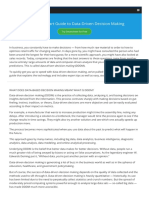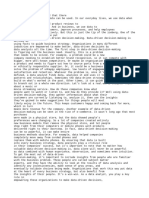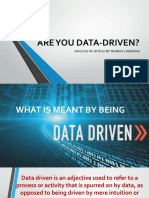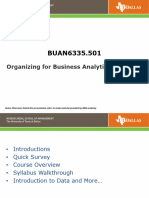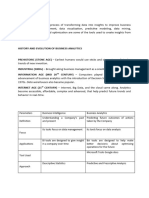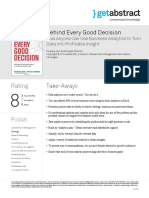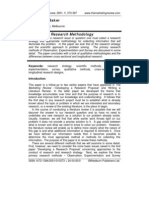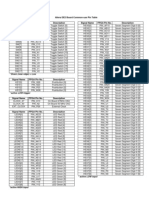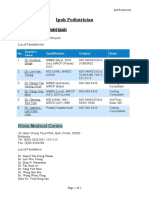0 ratings0% found this document useful (0 votes) 117 views3 pagesData-Driven Decision Making - A Primer For Beginners
Copyright
© © All Rights Reserved
We take content rights seriously. If you suspect this is your content,
claim it here.
Available Formats
Download as PDF or read online on Scribd
9190124, 12:53AM Data-Driven Decision Making: A Primo for Beginners
Data-Driven Decision Making: A Primer for Beginners
|y Shayna Joubert | August 22.2019
Inthe fila of data analytics, there are several buzzwords that, while important,
fined because of tner complexiy. These terms, such as “big data,”
“lous computing,” and “data-driven” can seem obscure fa laymen, One key fo success ina data analysis career, however, elo establish a fm
knowledge base by clearly dofning these toms eaty on.
Learning the language of dala analysis wil enhance your understanding and empower you to use this knowledge lo your advantage. Once you
Understand tne definition ofthe phrase “data-driven,” you can start applying the ac lo your decision-making and career as a data analyst
What Does It Mean to be “Data-Driven”?
Perhaps one ofthe most common buzzwords today is “big data.” But whats “big data” really? The term is generally used to describe the
‘magnitude and complexity of information. Even a small amount of content could be considered "bg data" if large amount of information has been
extracted fom it
Download Our Free Guide to Breaking Into Analytics
‘A guide to what you need to know, from the industry's most popular postions to today's sought-after data skis.
‘Then what does it moan to be “data-crivan?" This frm describes a decision-making process which invaWes collecting dala, extracting patterns
and facs fom that data, and utlizing those facs to make inferences tat inluence decsion-making
Data-triven decision making (or DDDM) isthe process of making organizational decisions based on actual data rather than intuon or
observation alone.
Every industry today sims tobe data-driven. No company, group, or organization says, “Let's not use the dat; our ntti alone wil lead to solid
decisions” Most professionals understand that without data—bias and flee assumptions (among other issues) can cloud judgment and load to
ipsifgraduate.northeastem edultesources/dala-drven-decision-making! 19�9190124, 12:53AM Data-Driven Decision Making: A Primo for Beginners
oor decision making. And yet, in a recent survey, 68 percent of respondents said tha thelr companies base atleast haf oftheir regular business
Aecisions on gu feel or intuition instead of data
How, then, can you ensure you're making data-criven decisions that are voi of bias and focused on clear questions that empower your
organization?
How to Make Data-Driven Decisions
‘To effectively utiize data, professionals must achieve the folowing:
1. Know your mission.
‘Awellrounded data analyst knows the business well and posses sharp organizational acumen. Ask yourself what the problems are in your gwen
Industry and compettive market, Idently and understand them thoroughly. Establishing this foundational knowledge wil equip you to make bettor
Inferences with your data later on.
Bofore you bogin collecting data, you should start by identifying tho business questions that you want to answor to achiove your organizational
goals. By determining the precise questions you need to know to inform your strategy, youl be able to streamine the data collection process and
avoid wasting resources.
2. Identify data sources.
Put together the sources from which youl be extracting your data. You might be coordinating information from diferent databases, web-driven
‘eedback forms, and even social medi
Coordinating your various sources seems simple, but riding common variables among each dataset can present a tremendously eificut problem,
Ian be easy to sete forthe immediate goal of ulizing the data for your current purpose alone, buts wise to determine whether or not his data
Could also be used for addtional projects in the future If 0, you should strive to develop a strategy to present the data in a way that's accessble
in other scenarios as well
3. Clean and organize data
Surprisingly, 80 percent of data analyst's tme i devoted to leaning and organisng ©. Data-Driven Decision
4a, and only 20 percents spent actualy performing analysis. This so-aled "8020
‘ule ilustates the importance of having clean, orderly information before you can
attempt intrpret walt might mean for your ogarizaton.
‘The tom “data cloaning refers to the pracess of preparing raw data for analysis by
remaving or careeting data that is incorrect, incomplete, ot relevant Ta do so, start,
by bulding tables to organize and catalog whal you've found. Creale a data dictionary
—a table that catalogs each of your variables and translates them into what they
‘moan to you inthe context ofthis particular projec, This information could include
data ype and other processing factors, as wal,
4. Perform statistical analysis.
(Once you've thoroughly cleaned the data, you can bagin lo analyze the information using statistical models. At this stage, you wil stat to buld
‘models to tast your data and answer the business questions you identified earlier inthe process, Testing alferent models such as linear
regressions, decision tres, random forest modeling, and obhers can help you determine which method is best sued to your dataset
Here, you wil algo need to decide how to prasent the information inorder to answer the question at hand. Thera are thres diferent ways to
demonstrate your findings:
Doser
Inferential Information: The facs, plus an interpretation of what those facts indicate inthe context ofa particular project.
Predictive Information: An inference based upon facts and advice for further action based on your reasoning
tive Information: Just he facts
Clarying how the information wil be m
31 effectively presented wil help you remain organizec when it comes time ta interpret the dat
ipsifgraduate.northeastem edultesources/dala-driven-decision-making!�9190124, 12:53AM Data-Driven Decision Making: A Primo for Beginners
5. Draw conclusions.
‘The last stp in data-driven decision making is coming toa conclusion. Ask yourset, “What new information did you learn from the collation of
statistics?" Despite pressure o discover something entirely new, & great place to start i by asking youl’ questions to which you already know—
or think you know—the answer.
Many companies make frequent assumptions about thelr products or market. Fr example, they might believe, “A marke for this product exists,”
"This what our customers wan.” But before seeking out new information, st put existing assumptions to te tet. Proving these assumptions
‘are correct wil give you foundation to work frm. Ateratvely,dispraving these assumptions wil allow yu to eliminate any flee claims that
have, perhaps unknowingly, ben negatively impacting your company. Keep in mind that an exceptional data-iven decision usually gen
‘more questions than answers,
‘The conclusions drawn from your analysis wil utimately helo your organization make more informed decisions and drive strategy moving forward.
Itis important to remember. though, tha these findings can be virtually useless if they are not presented effectively. Thus, data analysts must
become skied in the art of data styling to communicate thelr findings with key staxcholders as effectively as possible.
Data-Driven Decisions and Organizational Success
Incidental, the majoriy ofthe steps Isted above do not generate statistics. The majony of these steps to effectively utize data instead
encourage novice da
Understanding data from a holistic perspective and providing insight asad upon the data as wall
alts to become wellrounded in their rol. This process helps professionals become capable of not only analyzing, but
Josl Schwartz, a nonteaching afliate of Northeastern add, that i's worl asking, ‘Who isnt ulizing dat
because the mast successful companies almost always are. He continues:
riven decision making in my industry?
CConsier Netix, for example. The company started as @ mai-based OVD sharing business anc, based on a data-driven decision, grow to
internet streaming-—becoming one ofthe most successful companies today. Without data, Nelfix would nat hava had the basis to make such
lan immense and impactful decision. Moreover, witout that decision, the carmpany would not have flourished al the rate orn the erection it
i
‘Amazon is another poignant example, What started as an online bookstore has blossomed into a massive online hub for just about any
product a person could want or need. What drove tiem to make such enormous decisions? Data I's no surpige thal such major (and
successful) rebranding moves were made based on data colecton and the inferences made asa resull
Without the data-driven approach to decision making, Netix would stil be malin you an outdated made of movie content and Amazon would
be a simple online bookstore. The boll in is that this data-driven approach is puting all other methods out of business. The word is
becoming data.criven, and not make data-driven decisions would be foals.
Mastering Data-Driven Decision Making
Data-drven decision making is an
For novice data analysts who want to take @ more active part inthe decision-making proces at ther organization, fis essential to become familiar
sential process for any professional o understane, and itis especially valuable to those in data-oriented roles.
with what it means to be date-ven,
If you're looking to take the next step your data analytics carser, consider earning an advanced degree such as Northeastern Universiy’s Master
of Professional Stuces in Analytics. This program prepares students fr the competitive job market by providing them withthe essential data
analytics skills neaded to extract, develop, and deliver information for strategic decision making in organizations.
nipsifgraduate.northeastem edultesources/dala-drven-decision-making!
ery

